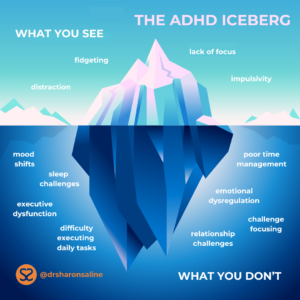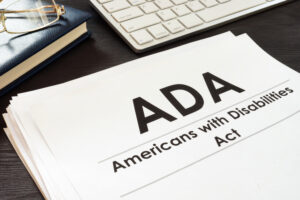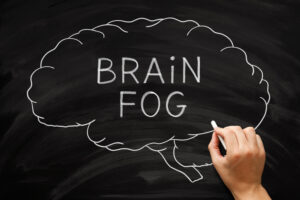“ICEBERG! Right ahead!!!”
Perhaps you remember this famous line from the iconic 1997 movie, “Titanic”, starring Leonardo DiCaprio and Kate Winslet. The ship’s captain alerted the passengers and crew of the historic vessel that they would soon strike a nearby iceberg that had been largely invisible, with 90% of the hulking iceberg being obscured underwater.
Within 30 seconds of sighting the iceberg, the ship made impact, sending the passengers and crew scrambling for safety amid the frigid waters. Had they been able to see more than just 10% of the iceberg – what was hidden below the surface – and adjust their course, disaster might have been averted. 
While certainly an excellent scene in the movie, the lessons learned from the ship’s collision with the iceberg are also a glimpse into the visible and invisible challenges of ADHD. The tip of the iceberg – the 10% we can see – represents behaviors and symptoms that are characterized as being “external”; meanwhile, the largest portion of the iceberg (what we can’t see) – represents those hidden symptoms and challenges that go unseen, characterized as being “internal”.
To celebrate ADHD Awareness Month, I’d like to explore the less visible ways ADHD impacts our lives and relationships. Let’s break down the ADHD Iceberg (first coined and depicted by Chris A. Ziegler Dendy) and how to manage it. You’ll be able to avoid unforeseen dangers and have smoother sailing.
The Iceberg We Can See – The External
Externalizing behaviors are frequently seen in the classroom, at the workplace and at home. They are easily observable and measurable, typically manifesting in inattention, impulsivity, and hyperactivity. They are related to conscious executive functioning skills such as verbal, behavioral and emotional impulse control, organization, time management, initiation and prioritizing. In children and teens, we see this tip of the ADHD more in boys than girls in common behaviors such as fidgeting, talking too much, interrupting others, moving around the classroom and physical aggression.
In adults, externalizing behaviors can manifest as missed deadlines, trouble with finances, tardiness, disorganized living spaces, difficulty remembering important dates or events, interrupting others, talking too much, job instability and strained relationships.
The Iceberg We Can’t See – The Internal
Internalizing ADHD behaviors are characterized as being less observable to others and frequently rely on someone’s self-report of their challenges in managing them.  These internal traits include a restless or wandering mind, low self- esteem, distractibility, inability to sustain attention, trouble with shifting or flexibility, overwhelm, limited self-awareness, poor working memory and shame.
These internal traits include a restless or wandering mind, low self- esteem, distractibility, inability to sustain attention, trouble with shifting or flexibility, overwhelm, limited self-awareness, poor working memory and shame.
Both types of these challenges exist in some form for everybody with ADHD. What’s under the surface of the water often shows up in combination with anxiety or depression, especially in girls and women with inattentive ADHD. Since these traits are less disruptive in a classroom, girls are less likely to be referred by educators which accounts for why women are one of the largest groups seeking ADHD diagnoses today. Dealing with all of these issues requires patience, sensitivity, and a genuine desire to understand the “whole person.”
Masking and the ADHD Iceberg
When the symptoms of ADHD remain hidden within the ADHD iceberg model, people rely on a coping response called “masking.” Both children and adults can engage in masking behaviors. Masking allows the person to conceal how their condition affects and limits their functioning.
ADHD masking is about conforming to neurotypical standards to avoid the shame and stigma related to being neurodivergent. It typically develops as a coping tool in childhood that continues into adulthood even though it may no longer be useful. Over time, masking becomes tough to maintain and prevents people from sharing who they really are.
The Consequences of Masking and the Unseen ADHD Iceberg
“I appear very organized to the outside world, but only because I spend an immense amount of time and energy putting everything together.” Cady, age 36
Masking with ADHD, while initially useful, may actually delay or sabotage a formal diagnosis and inadvertently foster the development of mental health issues such as anxiety or depression. Keeping symptoms of ADHD submerged and pretending they don’t exist to the outside world takes a great deal of energy. Diagnosed individuals who knowingly hide their challenges often worry profusely about being exposed and fear potential rejection or judgment.
Avoiding the unseen ADHD iceberg often exacerbates perfectionism and imposter syndrome. Going above and beyond, overpromising more than you can deliver and feeling overwhelmed in the process, you may hope to distract others from the inadequacy you deeply feel. In addition, years of intentional or unintentional masking can muddy one’s sense of self so you lose track of who you really are. Hiding the challenges of living with ADHD interferes with your ability to accept the brain you have, take pride in your strengths, and do more of what works.
4 Tips to Navigate the ADHD Iceberg
- Celebrate Strengths: Encouragement to focus on your strengths provides the space for you to be proud of who you are and embrace neurodiversity. It helps you to avoid the narrative that ADHD is something that bothers others, and should be hidden. It reduces the pressures to conform to others’ ideals. Some strengths of living with ADHD include: being energetic, spontaneous, enthusiastic, curious, creative, having quick thinking, being able to hyper-focus on what you love to do.
- Begin Journaling: Writing in a journal can help you process emotions and gain insight into your experiences. Your needs – and potential solutions – will become apparent as you consider these questions:
-
-
-
-
- If you weren’t masking, what else would you be doing?
- What obstacles or fears interfere with sharing your true self?
- How do your personal expectations help to maintain the submerged part of the ADHD iceberg?
- How can you make different, genuine choices in your behaviors or responses at home, at work or with friends?
-
-
-
3. Change Your Focus: Many people overcompensate for the deficits they think they have by overcommitting, overpromising, denial or avoidance. The negative self-talk that often accompanies masking can be shifted with paying attention to what is working. I recommend that you write or dictate three good things that happened in your day, ending with something you are grateful for each night before going to sleep. These positive items can be simple or complex. For example: 1) I wore my favorite shirt today; 2) I got the kids to school on time; 3) My boss liked my report. I’m grateful for the latte I had after lunch. This will take some practice but there’s research that shows this process really works.
4. Practice self-compassion. Treat yourself the way you would act with a close friend, a child or a beloved pet. Be kind, forgiving and understanding. Your masking developed to assist or protect you in the past but it may no longer be necessary. Hiding who you really are makes it impossible for you to obtain the assistance you need to be successful and share the wonderful parts of yourself with the world. Instead of judging yourself for being less than, cut yourself some slack. Put on your cloak of courage and learn to love your challenges instead of submerging them.


 that neurodivergence means ‘less than’. It’s so easy to fall into the cycle of “compare and despair”– looking at what other people are doing that you aren’t. Perfectionism is an inadequate attempt to overcompensate for this nagging sense of not measuring up. But, when you hold out your ADHD approval cup to others instead of filling it up yourself, you will always feel deficient.
that neurodivergence means ‘less than’. It’s so easy to fall into the cycle of “compare and despair”– looking at what other people are doing that you aren’t. Perfectionism is an inadequate attempt to overcompensate for this nagging sense of not measuring up. But, when you hold out your ADHD approval cup to others instead of filling it up yourself, you will always feel deficient.  perfectionists. More than just positive thinking, a growth mindset is about accepting yourself for who you are while opening your heart and your mind to learning and improving. It’s about understanding that we grow through trial and error, and that mistakes are part of that process. Errors don’t make you a failure, they reflect your natural humanity. Perfection is not the yardstick against which you measure yourself. Aim for steadiness, consistency, and self-compassion instead. When you live with ADHD, it’s easy to fall back on perfectionism to compensate for executive functioning challenges and social insecurities. Unfortunately, this only feeds the pattern of needing approval to be ‘okay’. A growth mindset along with self acceptance will help you nurture essential resilience and lead you to share what is wonderful about yourself – warts and all.
perfectionists. More than just positive thinking, a growth mindset is about accepting yourself for who you are while opening your heart and your mind to learning and improving. It’s about understanding that we grow through trial and error, and that mistakes are part of that process. Errors don’t make you a failure, they reflect your natural humanity. Perfection is not the yardstick against which you measure yourself. Aim for steadiness, consistency, and self-compassion instead. When you live with ADHD, it’s easy to fall back on perfectionism to compensate for executive functioning challenges and social insecurities. Unfortunately, this only feeds the pattern of needing approval to be ‘okay’. A growth mindset along with self acceptance will help you nurture essential resilience and lead you to share what is wonderful about yourself – warts and all. 

 impact how you function cognitively–your thinking, your recall and your concentration. It can also reflect difficulty with making decisions, mental fatigue, slower response time and uncertainty. While we don’t know what causes brain fog exactly, research shows that it’s associated with
impact how you function cognitively–your thinking, your recall and your concentration. It can also reflect difficulty with making decisions, mental fatigue, slower response time and uncertainty. While we don’t know what causes brain fog exactly, research shows that it’s associated with  things, if you will arrive on time, and if people will like you.
things, if you will arrive on time, and if people will like you.
 hyperfocus, try breaking tasks down into 30-45 minute work blocks. You want to give your brain time to reset and rest a bit throughout the day rather than go intooverdrive and burnout. It can be tough for a lot of people who like to hunker down and plow through a set of projects. But overworking like this uses up the natural glucose fuel in the brain and then relies on cortisol. You wind up creating stress that doesn’t need to be there. Trying to remember everything also adds pressure. Give yourself a break and write things down. This also reduces stress and gives you the visual cues you need to be productive and stay focused.
hyperfocus, try breaking tasks down into 30-45 minute work blocks. You want to give your brain time to reset and rest a bit throughout the day rather than go intooverdrive and burnout. It can be tough for a lot of people who like to hunker down and plow through a set of projects. But overworking like this uses up the natural glucose fuel in the brain and then relies on cortisol. You wind up creating stress that doesn’t need to be there. Trying to remember everything also adds pressure. Give yourself a break and write things down. This also reduces stress and gives you the visual cues you need to be productive and stay focused. lunches, our parental priorities shift from “summer fun” to “get it done.” The back-to-school transition helps set the stage for a successful school year. It is
lunches, our parental priorities shift from “summer fun” to “get it done.” The back-to-school transition helps set the stage for a successful school year. It is



 some circumstances, it’s not completely a lie if a child or teen truly doesn’t
some circumstances, it’s not completely a lie if a child or teen truly doesn’t  do not follow agreed upon house agreements and when they are oppositional. Withdrawals can result in the loss of earned privileges. It’s more helpful to set up consequences in advance rather than create them on the fly when you are distressed.
do not follow agreed upon house agreements and when they are oppositional. Withdrawals can result in the loss of earned privileges. It’s more helpful to set up consequences in advance rather than create them on the fly when you are distressed. 
 the dark corners in your mind of insecurity and self-doubt. Wasn’t the lasagna a bit soggy? Were the games too babyish? Did people really have fun or just say so to be polite? Despite the outward success of the day, you’ve circled right back to feeling like a failure with a bit of shame and self loathing thrown in for good measure. Your underlying depression and its symptoms have officially re-entered the arena.
the dark corners in your mind of insecurity and self-doubt. Wasn’t the lasagna a bit soggy? Were the games too babyish? Did people really have fun or just say so to be polite? Despite the outward success of the day, you’ve circled right back to feeling like a failure with a bit of shame and self loathing thrown in for good measure. Your underlying depression and its symptoms have officially re-entered the arena.  Depression is a complex mental health condition with a variety of symptoms that can affect somebody’s physicial, cognitive and emotional functioning. Typical signs of depression include: feelings of sadness, hopelessness or worthless; irritability; changes in sleep patterns (too much, interrupted sleep or too little); lethargy including; physical problems (including headaches or digestive issues) with no clear cause; suicidal thoughts or attempts; increased use of drugs or alcohol; isolation and withdrawal from social contact.
Depression is a complex mental health condition with a variety of symptoms that can affect somebody’s physicial, cognitive and emotional functioning. Typical signs of depression include: feelings of sadness, hopelessness or worthless; irritability; changes in sleep patterns (too much, interrupted sleep or too little); lethargy including; physical problems (including headaches or digestive issues) with no clear cause; suicidal thoughts or attempts; increased use of drugs or alcohol; isolation and withdrawal from social contact.  People with depression and ADHD may experience chronic brain fog due to feeling emotionally overloaded in conjunction with their biological attentional challenges. They may also experience low motivation, a lack of joy from activities they previously enjoyed, persistent low energy and profound sadness.
People with depression and ADHD may experience chronic brain fog due to feeling emotionally overloaded in conjunction with their biological attentional challenges. They may also experience low motivation, a lack of joy from activities they previously enjoyed, persistent low energy and profound sadness.
 overwhelm, and depression than boys and men. So it can be expected that there are female-specific symptoms and manifestations of ADHD at different stages of a woman’s life. Moreover, there is evidence of the relationship between declining hormone levels, mood and cognitive capacity. Let’s take a closer look at how menopause can affect ADHD and what you can expect in this season of your life.
overwhelm, and depression than boys and men. So it can be expected that there are female-specific symptoms and manifestations of ADHD at different stages of a woman’s life. Moreover, there is evidence of the relationship between declining hormone levels, mood and cognitive capacity. Let’s take a closer look at how menopause can affect ADHD and what you can expect in this season of your life. issues, and time-management difficulties. And women over 60 reported struggling with brain fog and memory issues, procrastination, and overwhelm. It is still not clear whether menopause amplifies ADHD symptoms or vice versa. Regardless, these and other issues like difficulty sleeping and mood swings need to be managed.
issues, and time-management difficulties. And women over 60 reported struggling with brain fog and memory issues, procrastination, and overwhelm. It is still not clear whether menopause amplifies ADHD symptoms or vice versa. Regardless, these and other issues like difficulty sleeping and mood swings need to be managed.
 Are you ever so engrossed in an activity you love that you completely lose track of time? Does it seem like you lose sense of where you are and what’s happening around you? And when you snap back into the reality of what’s going on around you, are you disoriented? People with ADHD and neurodivergence are more likely to experience this heightened state of focus known as “hyperfixation” than neurotypical children and adults. Hyperfixation is defined as full immersion in something of interest to a point where a person appears to ‘tune out’ everything else. While this can be viewed as a productivity superpower, it can also draw you into unproductive, procrastinating activities. That’s part of what makes it both exhilarating and frustrating.
Are you ever so engrossed in an activity you love that you completely lose track of time? Does it seem like you lose sense of where you are and what’s happening around you? And when you snap back into the reality of what’s going on around you, are you disoriented? People with ADHD and neurodivergence are more likely to experience this heightened state of focus known as “hyperfixation” than neurotypical children and adults. Hyperfixation is defined as full immersion in something of interest to a point where a person appears to ‘tune out’ everything else. While this can be viewed as a productivity superpower, it can also draw you into unproductive, procrastinating activities. That’s part of what makes it both exhilarating and frustrating. On the other hand, hyperfocus is task-driven and is often accompanied by clear goals and a sense of purpose. It’s less about enjoyment and satisfaction and more about getting into the flow of an activity. It’s a state of being fully engaged in a task for which you have a clear sense of direction. Hyperfocus is linked to increased productivity and a sense of accomplishment.
On the other hand, hyperfocus is task-driven and is often accompanied by clear goals and a sense of purpose. It’s less about enjoyment and satisfaction and more about getting into the flow of an activity. It’s a state of being fully engaged in a task for which you have a clear sense of direction. Hyperfocus is linked to increased productivity and a sense of accomplishment. Here are four strategies to assist adults with ADHD with managing hyperfixation and using it as a superpower:
Here are four strategies to assist adults with ADHD with managing hyperfixation and using it as a superpower: 
 While it’s unrealistic to eliminate negative thinking, reducing its power and influence is crucial for fostering self esteem and resilience–two key issues for women.
While it’s unrealistic to eliminate negative thinking, reducing its power and influence is crucial for fostering self esteem and resilience–two key issues for women.  The most powerful tool women have to counter negative thinking is self-esteem and its cousin, resilience. Confidence empowers you to make decisions, get through life’s ups and downs and recover after setbacks. It’s your inner ally. Confidence also helps quiet the inner critic by reassuring it that your wise, inner self has the resources to meet whatever challenges you are facing. So while you’re quieting your inner critic, turn up the volume on the voice that nurtures you with compassion, kindness and support.
The most powerful tool women have to counter negative thinking is self-esteem and its cousin, resilience. Confidence empowers you to make decisions, get through life’s ups and downs and recover after setbacks. It’s your inner ally. Confidence also helps quiet the inner critic by reassuring it that your wise, inner self has the resources to meet whatever challenges you are facing. So while you’re quieting your inner critic, turn up the volume on the voice that nurtures you with compassion, kindness and support. If you’ve been stuck in a pattern of knocking yourself down, learning to pull yourself back up takes A LOT of practice and grit. Learning to control the volume on that negative voice is a life skill based on persistent resilience and genuine self-esteem. It’s one step at a time so stay patient because two steps forward and one step backwards is still forward motion.
If you’ve been stuck in a pattern of knocking yourself down, learning to pull yourself back up takes A LOT of practice and grit. Learning to control the volume on that negative voice is a life skill based on persistent resilience and genuine self-esteem. It’s one step at a time so stay patient because two steps forward and one step backwards is still forward motion. 